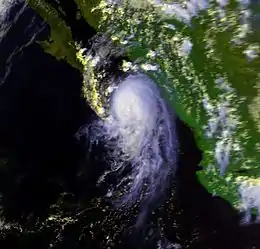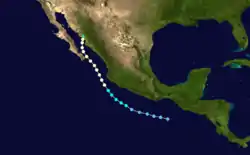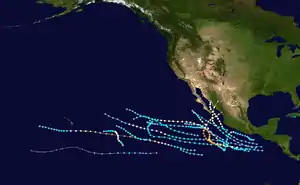Hurricane Newton (1986)
Hurricane Newton was one of the few tropical cyclones that were intercepted by Hurricane Hunter flights during the moderately active 1986 Pacific hurricane season. A tropical depression formed near Central America on September 18; two days later, the depression was upgraded into a tropical storm. Moving towards to northwest, Newton strengthened into a hurricane on September 21. After paralleling the coast, Newton move ashore near Cabo San Lucas on September 22. Shortly after entering the Gulf of California, the hurricane attaining its peak intensity of 85 mph (145 km/h). The following day, Newton moved ashore the Mexican mainland. Newton dissipated on September 23. However, the remnants of Newton continued across the United States and eventually emerged into the Atlantic Ocean. While 40 homes lost their roofs, damage in Mexico was fairly minor, and no fatalities were reported in association with Newton, though the remnants produced fairly heavy rains in the Great Plains.
| Category 1 hurricane (SSHWS/NWS) | |
 Hurricane Newton | |
| Formed | September 18, 1986 |
|---|---|
| Dissipated | September 23, 1986 |
| Highest winds | 1-minute sustained: 85 mph (140 km/h) |
| Lowest pressure | 984 mbar (hPa); 29.06 inHg |
| Fatalities | None |
| Damage | Minimal |
| Areas affected | Mexico, United States |
| Part of the 1986 Pacific hurricane season | |
Meteorological history

The origins of Newton were from a tropical disturbed weather near Nicaragua in mid-September. Steered by an upper-level trough located over the Western United States, the system moved westward and developed into a tropical depression at 1200 UTC on September 18. It was located beneath an anticyclone situated the Central United States and over sea surface temperatures of 84 °F (29 °C).[1][2] The system steadily intensified as it paralleled the Mexican coast, and was upgraded into Tropical Storm Newton early on September 20.[2] Within 24 hours, Newton had attained winds of 60 mph (95 km/h). Meanwhile, the storm turned northwest.[3] At 0600 UTC September 21, the Eastern Pacific Hurricane Center (EPHC) reported that Newton had attained hurricane strength[2] while located about 200 mi (320 km) west-northwest of Manzanillo, Colima.[3]
Shortly after becoming a hurricane, a NOAA Hurricane Hunter aircraft investigated Newton. The aircraft passed the center on 1800 UTC September 21, observing winds of 74 mph (119 km/h) to 79 mph (127 km/h). Six hours later, the hurricane reached its minimum pressure of 984 mb (29.1 inHg). Hurricane Newton was one of the few storms to be intercepted by the aircraft that season.[2] After moving north-northwest, the hurricane briefly turned northwest, in the general direction of the Baja California Peninsula the next day.[3] On 1800 UTC September 22, Hurricane Newton made landfall 29 mi (47 km) from Cape Pulmo, a town situated northeast of Cabo San Lucas as a Category 1 hurricane on the Saffir-Simpson Hurricane Scale. After emerging into the Gulf of California, the storm reached its peak wind speed of 85 mph (135 km/h). At this time the tropical cyclone was situated about 60 mi (97 km) north of La Paz, Baja California Sur.[3] By 1800 UTC September 23, the hurricane moved ashore near Punta Rosa and quickly dissipated.[2] The remains of the cyclone moved into New Mexico. The remnants of Hurricane Newton transversed the Central United States and the Mid-Atlantic States until it entered the Atlantic Ocean later in the month.[1]
Preparations and impact
Prior to the system's first landfall, the EPHC noted the threat of high waves, storm surge, and flooding. In addition, the navy, army, and police were on high alert in populated areas like La Paz due to the hurricane.[4] On the mainland, roughly 700 people evacuated to shelters in Huatampo, a city that at that time had a population of 9,000, and Yavaros prior to landfall, but within hours after the passage of the hurricane, all but 127 had returned home.[5]
Upon making landfall on the Baja California Peninsula, moderate rainfall was recorded though officials reported no emergencies.[4] In Huatabampo, roofs were blown off of 40 homes.[5] High winds blew down trees and utility poles.[6] In addition, a peak rainfall total of 9.23 inches (234 mm) was reported in Jopala.[1] Overall, damage in Mexico was minor[6] and less than anticipated.[5] No injuries or fatalities were reported in association with Newton.[6][7] Because Hurricane Newton, along with a cold front, was predicted to cause heavy rains over portions of the United States, flash flood warnings and watches were issued by the National Weather Service for parts of western Texas, New Mexico, and Arizona.[8][9] Across the country, the highest rainfall was 5.88 inches (149 mm) in Edwardsville, Kansas. The rainfall extended as far east as Pennsylvania.[1] In Kansas City, Missouri, 20,000 customers were without power since heavy rainfall downed power lines.[10]
See also
- Other tropical cyclones named Newton
- Hurricane Roslyn-similar storm
- Hurricane Paine-similar storm
- 1986 Pacific hurricane season
- List of Pacific hurricanes
References
- David Roth (2007). "Hurricane Newton - September 17–26, 1986". Hydrometeorological Prediction Center. Retrieved August 10, 2007.
- Gunther, Emil B.; R.L. Cross (October 1987). "Eastern North Pacific Tropical Cyclones of 1986". Monthly Weather Review. 115 (10): 2507–2523. Bibcode:1987MWRv..115.2507G. doi:10.1175/1520-0493(1987)115<2507:ENPTCO>2.0.CO;2.
- National Hurricane Center; Hurricane Research Division; Central Pacific Hurricane Center. "The Northeast and North Central Pacific hurricane database 1949–2019". United States National Oceanic and Atmospheric Administration's National Weather Service. Retrieved 1 October 2020. A guide on how to read the database is available here.
- "Hurricane moves northwest". The Lewiston Journal. September 23, 1986. Retrieved August 29, 2011.
- "Hurricane lashes Mexico coast". The Day. September 23, 1986. Retrieved March 6, 2013.
- "Hurricane Newton rips across Mexico". Daily Herald. September 24, 1986.
- "Pacific Hurricane hits northwest Pacific coast". Ocala Star-Banner. September 25, 1986.
- "Around the Nation". The Capital. September 24, 1986.
- "Storms Raged Across Nation". The Telegraph-Herald. September 24, 1986. Retrieved August 28, 2011.
- "Winter rears its ugly..." Lodi News-Sentinel. September 25, 1986. Retrieved August 29, 2011.
